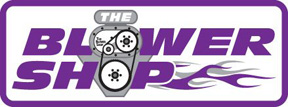|
 20 Most Asked Questions About
Blower Motors 20 Most Asked Questions About
Blower Motors
|
|
Q: Can I use a roller cam for the street? |
|
A:
Roller Cams will work in most applications as long as the camshaft grind is designed
for blower applications. |
|
Q: What carbs do I need to run and why 2 of them? |
|
A:
The size of carb(s) or CFM required for a given application can be calculated by the
following formula: {(CID X RPM) / 3456} X {Boost / 14.7) + 1} = CFM required. The amount
of CFM required will determine carburetor size and quantity. If you try to use a carb with
less CFM than required, performance and economy may be greatly reduced.
more... |
|
Q:
When do I start making boost? |
|
A:
The amount of boost and the RPM at which boost starts is controlled by the throttle
blower size and drive ratio, engine size, camshaft profile, and exhaust system. All of
these factors determine the breathing capability of the blown engine. Boost should only be
measured at wide-open throttle at 6,000RPM. If there is only part throttle, the blower
cannot get enough air to overcome the demands of the engine. Only when the blower can get
enough air will there be boost. Once can install a
boost-memory gauge to
assist in the reading.
|
|
Q: Why are my exhaust pipes red hot? |
|
A:
Exhaust pipes get red hot for two basic reasons. Either the ignition timing is
incorrect or the engine is running extremely lean. There are other causes but these are
the two most common. Ignition timing is extremely critical. Blown motors love advance.
Without enough initial timing advance, blown motors will run hot and the exhaust pipes
will glow in the dark. Blown motors should not run less than 16 degrees or
greater than 26 degrees initial advance with the total advance of about 32-36 degrees at 2500 RPM to
3000RPM. Specific timing requirements depend on compression, blower drive ratio, engine
load, camshaft, and fuel octane.
Zoomie headers
are recommended for all-out competition |
|
Q: Why do you recommend such low compression when my buddy’s
system is running 9:1 and it’s running good? |
|
A:
Low compression enables two things to be accomplished. One, the lower compression
lets us run higher blower boost producing more low end and midrange torque and two, when
the engine does not have boost from the blower, the engine runs more cool and effortlessly
making the engine last a long time. |
|
Q: Why does my engine run hot? |
|
A:
Over heating of a blown motor may be caused by too high compression ratio, too high
blower drive ratio, improper timing, poor water flow through manifold, or an inadequate
and inefficient cooling system. |
|
Q: Why does retarded timing attribute to overheating? |
|
A:
Ignition timing deals with the time at which ignition occurs during the compression
stroke. Retarded timing ignites the air/fuel mixture closer to maximum compression then
advanced timing. Higher compression at the point of the ignition means hotter temperatures
from the burning of the air/fuel mixture and this translates into a hotter running engine. |
|
Q: Which is stronger, ½ pitch or 8mm drives? |
|
A:
The 8mm, round tooth profile is capable of transferring as much as 40% more power
than the ½ inch pitch, square tooth profile. As a general rule ½ inch pitch is good up
to 12-15% overdrive on most blower applications. Large blowers and high drive ratios
should use the 8mm or 14mm, round tooth design.
more... |
|
Q: How much space does a blower drive take in front of the
engine? |
|
A:
The amount of space in front of the motor for the blower drive system depends on the
width of the blower pulleys and the number of accessory V- groove pulleys needed for each
application. An easy rule of thumb is to add the width of the blower pulleys to the front
edge of the V-pulley furthest from the engine block. |
|
Q: When I start my car it backfires, why? |
|
A:
There are many reasons why a engine will backfire but the most common problem with
blown motors is holding the throttle open while cranking the engine over. It is better to
give the throttle a few pumps (2), and take your foot off the accelerator before turning
the engine over and count slowly to ten. When the engine does fire and begin to run,
quickly catch the throttle and raise the engine idle at about 2000 RPM until some heat can
be built in the motor, about two minutes. Trying to engage the engine before enough heat
is built usually results in an engine that spits, sputters, backfires, an/or dies. |
|
Q: Do I run an oil line from the blower to the engine?
If not how much oil do I put in the blower Case? |
|
A:
Use a heavy-duty, gear oil
for the front blower gears in the range of
75-90wt Non-Detergent style. Do NOT run a line
from the engine oil. Depending on the blower size will determine the amount
of gear oil to use. Smaller blower (6.71-8.71) will usually take about 16oz.
Larger blowers (10.71-14.71) can take up to 20oz. Most blowers will have an
oil sight glass in which you can fill it up until you see it half way up the
sight glass. On blowers with no sight glass you can remove the snout bolt in
the 7 O'clock position and fill the case up until is starts to leak out of
that hole. Once you have done that the blower case is filled and you are
ready to run that blower.
more... |
|
Q: Should I use gapless rings? |
|
A:
Testing with
gapless rings in a supercharged engine shows excellent increase in
performance. |
|
Q: Steel or aluminum rods, which are better? |
|
A:
Both styles of rods are well suited for blown applications. Steel rods are generally
used in motors that must produce a long service life. Aluminum rods are generally used for
engines seeking high horsepower output and not long service lives. |
|
Q: Can blower whine be eliminated or made louder? |
|
A:
Blower whine can be increased or decreased by tightening or loosening the blower
belt tension. CAUTION! Improper belt tension can cause severe belt, blower and engine
damage. It is not recommended to adjust the belt to get the sound you want. Worn pulleys
and belts as well as mis-machined pulleys can contribute to blower whine. |
|
Q: My engine builder is determined not to use a crank hub on my
blown motor, only a harmonic balancer, what do you say? |
|
A:
We do not recommend any type of cast iron balancer because they break easily.
Any hi-quality heat-treated after market steel harmonic balancer with two
keyways (one 3/16" and the second a ¼" keyway located 180 degrees apart) will
perform very well. Be sure to notify us at the time you order your blower kit if you will be using an
after market harmonic balancer, we will accommodate this kit change when ordered
initially. On any large cubic inch high horsepower system we recommend that you use our
heat-treated heavy-duty 4130 chromally steel
crank hubs. |
|
Q: My car won’t idle? |
|
A:
Idling problems with blown motors is usually a result of a severe vacuum leak,
improper ignition timing, or improperly adjusted carbs or fuel injection. |
|
Q: My plugs are black? |
|
A:
Black sooty plugs are a direct result of too much fuel. The carbs or fuel injection
is not properly adjusted or set up for your engine, correct your fuel delivery system. |
|
Q: Where should my timing be? |
|
A:
Blowers love ignition advance. Especially initial
advance. For most blower applications the initial timing should be set at 16-26
degrees initial advance with a total of 32-36 degrees advance, in all by
2500-2800 RPM. More advance can be run if there is not a detonation problem.
Some vacuum advance systems will have as much as 45-50 degrees total advance
under part throttle, cruise conditions. |
